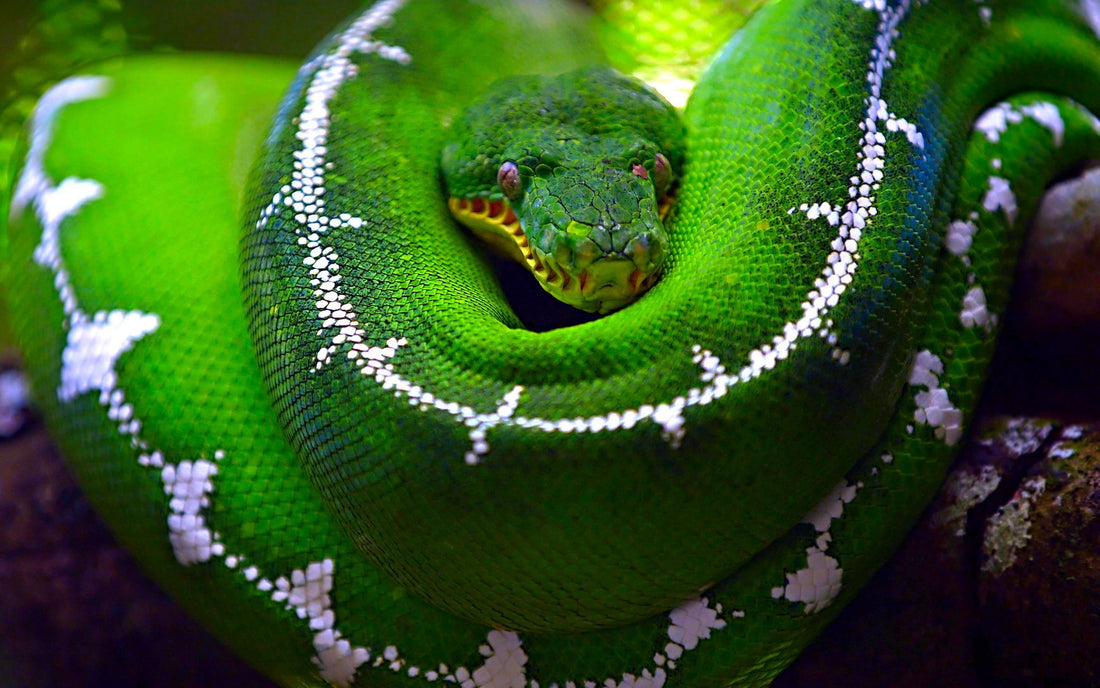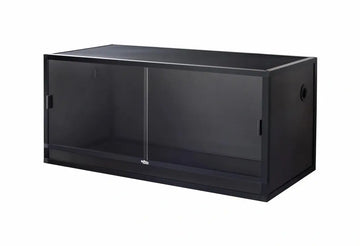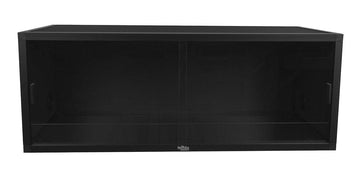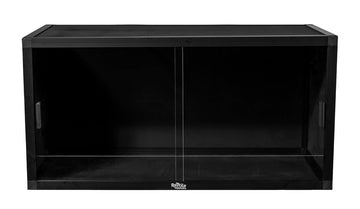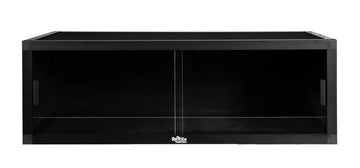Emerald tree boas (Corallus caninus) are 4-9’ long, arboreal snakes native to the Guyana and Amazon Basin regions of South America. They generally prefer a lowland tropical rainforest habitat, where they spend most of their time in trees and shrubs.
Emerald tree boas look different based on locality. The northern locality has a green body with a white belly and white markings, and is smaller at 4-6’ long. The southern locality has a dark green body with a yellow belly and white markings, and can grow as large as 9’ long. Differences aside, all emerald tree bodies have slender, muscular bodies, blocky heads, bulbous snouts, and prominent heat pits.
Their stunning appearance makes emerald tree boas popular display animals. Due to their size, temperament, and susceptibility to dehydration, emerald tree boas are advanced-level pet reptiles. But with good care, emerald tree boas can have a 20+ year lifespan.
Minimum terrarium size for emerald tree boas
The absolute minimum terrarium size for a single emerald tree boa is 48”L x 24”W x 48”H. Of course, larger is always better! Emerald tree boas may look small due to their slender bodies, and tendency to coil up on a branch, but the fact is that they still need enough room to stretch out fully, climb, and thermoregulate.
Cohabitation (keeping multiple emerald tree boas in one enclosure) is not recommended, as keeping them together is likely to cause stress.
Do emerald tree boas need UVB?
Technically they can survive without it, but we still recommend providing appropriate UVB lighting for emerald tree boas. UVB lighting helps provide a clear day/night cycle, provides all of the vitamin D that your pet needs, strengthens the immune system, facilitates better digestion, and provides other benefits. Plus, it’s quite likely that they are regularly exposed to sunlight in the wild, as emerald tree boas are known to be active during both day and night.
The best UVB bulbs for emerald tree boas housed in a 48” x 24” x 48” terrarium are:
- Zoo Med Reptisun T5 HO 5.0, 34”
- Arcadia Forest 6%, 34”
For best results, house the UVB bulbs in a reflective fixture such as Vivarium Electronics or the Arcadia ProT5. Position the lamp on the same side of the terrarium as the heat lamp, about 11-13” above the basking branch if over mesh, and 14-16” above the basking branch if not.
UVB is blocked by glass and plastic, so placing the terrarium in front of a window doesn’t count as “free UVB” — in fact it can make your terrarium too hot due to the greenhouse effect. Don’t forget to replace your bulb every 12 months!
Lights should be on for 12 hours/day.
Best temperature for emerald tree boas
Like other reptiles, emerald tree boas are cold-blooded, which means that they rely on external temperatures to manage their own body temperature and metabolism. A reptile’s enclosure should offer a range of temperatures to allow them to thermoregulate effectively.
Specifically speaking, emerald tree boas should have a basking air temperature between 88-93°F. Average ambient temperature should be around 84°F, dropping to around 78°F at night. Make sure you’re maintaining an appropriate temperature gradient with digital probe thermometers.
Provide heat for your snake with at least two heat bulbs, placed close together over the basking area (ex: a piece of flagstone or stone paver) to evenly heat the snake’s entire body. Do not use ceramic heat emitters (CHEs), red bulbs, or blue bulbs, as these are not as effective. If the bubs are a little too hot, use a plug-in lamp dimmer to reduce output. If the bulbs are not hot enough, you will need a higher wattage.
Best humidity levels for emerald tree boas
Emerald tree boas are a tropical species that requires an average humidity of 70-80%. They are very sensitive to dehydration, so it’s important to keep them appropriately hydrated, but that doesn’t mean their enclosure should always be soaking wet, either. Humidity should be monitored via digital probe hygrometer, with the probe placed in the middle of the terrarium.
Increase humidity by misting your snake’s enclosure 1-2x/day with a spray bottle or automatic misting system. Mist first thing in the morning and then again at night if needed. A cool mist humidifier connected to a hygrostat can also help. We also recommend installing a humid hide for your snake, lined with moistened sphagnum moss, in the upper levels of the enclosure.
Best substrate for emerald tree boas
Providing a thick layer of naturalistic substrate (“bedding”) will help maintain correct humidity levels and helps make your enclosure more attractive! We recommend the following substrates for emerald tree boas:
Layering clean, chemical-free leaf litter on top of the substrate can also help with humidity. Substrate should be at least 4” deep and completely replaced every 3-4 months. Remove poop and urates daily, along with contaminated substrate.
During quarantine, it can be helpful to use puppy training pads to maintain humidity while also making the enclosure easy to clean.
How to decorate an emerald tree boa terrarium
An empty terrarium makes for a bored snake, reducing its quality of life. Keep your pet entertained and engaged with its environment with the strategic use of décor items that encourage it to exercise natural behaviors!
Since emerald tree boas are arboreal (and proficient climbers at that), it is extremely important to provide branches for it to climb and perch on. Branches should be roughly the same width as the thickest point of the snake’s body, and the main perch should be removable so the snake can be easily removed from the enclosure when needed.
Here are some other ideas to consider:
- vines
- cork tubes
- ledges
- live or artificial plants
Aside from branches, make sure that your snake also has covered areas to retreat to when it wants privacy.
What to feed to an emerald tree boa
Emerald tree boas are carnivorous, which means that they need to eat whole animal prey in order to get the right nutrition. Here is a basic feeding schedule based on snake age:
- Newborns should be fed once every 10 days.
- Juveniles should be fed once every 2-3 weeks.
- Adults should be fed once every 3-4 weeks.
Prey items should be around 10% of the snake’s weight and/or roughly the same width at its widest point. Appropriate prey options include mice, rats, hamsters, gerbils, quail, and chicks. For best nutrition, offer a variety of prey.
Although live prey can be offered, it’s best to use frozen whenever possible. Prey should be thawed in a BPA-free plastic bag in warm water until it reaches ~100°F, then use a pair of soft-tipped feeding tweezers to offer it to your snake.
Supplements
Snakes can survive without dietary supplements, but using them every once in a while can help prevent your pet from developing a nutritional deficiency, helping it live healthier. We recommend Repashy Calcium Plus LoD, lightly dusted on the prey item before offering.
Water
Emerald tree boas need constant access to drinking water. Keep the water clean and free of debris, and scrub the bowl with a reptile-safe disinfectant weekly or whenever it becomes soiled.
How to handle your emerald tree boa
Reptiles generally don’t appreciate petting and handling in the same way that dogs and cats do, and emerald tree boas definitely prefer to be left alone rather than handled. This means they’re happiest as a display animal. But when you need to work in your boa’s enclosure, use a snake hook or paper towel to keep the snake occupied. If you’re worried about getting bitten, wear a pair of welding gloves and a face shield.
*This care sheet contains only very basic information. Although it’s a good introduction, please further your research with high-quality sources. The more you know, the better you will be able to care for your pet!

